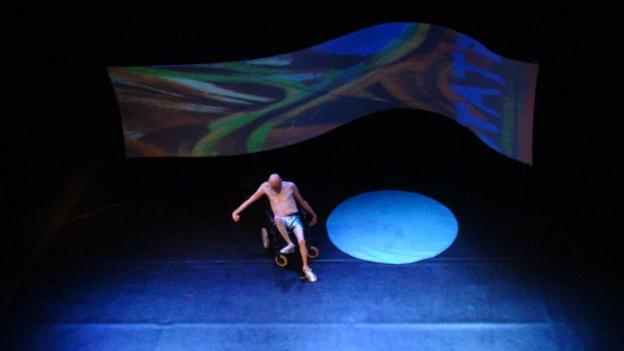Meet Pete. He has a shaved head and skinny legs, and he’s dressed in a pair of turquoise-blue shorts and sparkly trainers. Pete has a story to tell – the story of a quest for love. Pete is gay and has a predilection for men with a bit of fat on them.
We start with a big-screen film of London’s South Bank, and the camera’s eye takes us past streetlamps and over the river wall to the shimmering waters below. It’s beautiful, a visual reminder of how vital the River Thames is to London’s heart and soul.
Enter Pete, who uses a wheelchair and has a voice that is kind of hard to understand if you are not used to it, so he’s provided subtitles for his spoken commentary. At first my eyes are drawn a lot to the titles; as the show progresses I find myself listening rather than reading, learning and understanding more, discerning the patterns in the spoken language. It’s all just a matter of time and effort. As Pete talks to us he moves his chair around the space, in a gentle choreography, often coming close to us, then retreating. In the centre of the floorspace is a circular blue crash-mat.
Pete reflects on his walk by the riverbank, and eulogises on the beauty of the moment. The London Eye passes by in the background and Pete tells us he’s been on it six times. We also learn of his love of street art as the camera passes the skateboarders and graffiti writers of the Southbank. We are taken through his journey as if it is in present time. ‘What would make this perfect,’ he says, ‘is if I could meet a beautiful fat man tonight.’
The journey then divides into three different strands, developed through film, spoken text, and physical action in the space: we have the ‘city symphony’ in which Pete paints a picture of London’s beautiful river landscape and monuments – Shakespeare’s Globe, the Gherkin (‘Beautiful, erotic!’) – as well as such smaller quieter stuff as a paper bag blowing in the wind. Then there is the folkloric/archetypal dream-journey, in which we hear fantastical tales of leaping over the sides into the water to commune with mermen; or a bizarre and hilarious story of the disappearance of all the men from London, which is then taken over by cats who make all the women cut off their long hair and cook it; or again a fantasy built around the dome of St Paul’s Cathedral, which is turned into a kind of human stew pot. The third strand is the journey of the sexual quest. This strand sits between the reality of the first one and the total fantasy of the second – a realistic dream, you might say. Perhaps it happened, perhaps it didn’t.
The man Pete meets – Dave – offers him a Coke and invites him back to eat spaghetti. We see the spaghetti cooked on film, and live in the space we see Pete assisted in moving from his wheelchair onto the blue mat, his clothes removed, and a plate of spaghetti brought to him, the messy spaghetti eating becoming a metaphor for the sexual encounter. Throughout the show, the links between food and sex are paramount.
What I enjoyed most about the show was that it reaffirmed things I knew and loved, yet showed me new things. As a Londoner born and bred, I was drawn instantly to this homage to my city of birth, and identified with both the real-life portrait of an area I know well and the dream-imagery connected to London’s river and monuments (reminding me a little of the fantasy writings about and around the Thames authored by Jeanette Winterson, Russell Hoban and, more recently, Ben Aaronovitch). The story of the sexual desires and quests of a gay disabled man were the new element for me – here’s a story I haven’t heard before and felt pleased to have been invited in on. And of course we are none of us often presented with someone with extreme physical disabilities on a stage, there to be looked at and listened to, fairly and squarely. No need to stare, but no need to look away either. Just look, and see the person before us.
The show is pitched somewhere between performance art and theatre – performance art in that we are presented with this person, this body in this space at this moment in time: there’s no acting, no character, no ‘other’.
Yet in its realisation – the integration of soundscape, moving image, spoken text, physical action – it has a rhythm and direction that shows a keen awareness of dramaturgy. In other words, it’s a great story, told well! A very beautiful and moving piece of ‘total theatre’.


